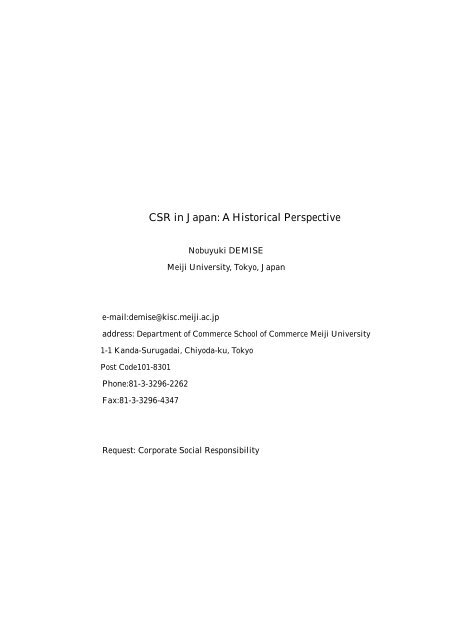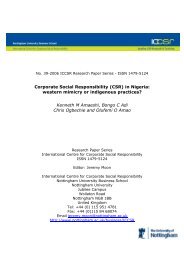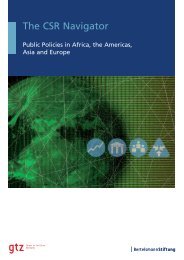CSR in Japan: A Historical Perspective - CSR WeltWeit
CSR in Japan: A Historical Perspective - CSR WeltWeit
CSR in Japan: A Historical Perspective - CSR WeltWeit
Create successful ePaper yourself
Turn your PDF publications into a flip-book with our unique Google optimized e-Paper software.
<strong>CSR</strong> <strong>in</strong> <strong>Japan</strong>: A <strong>Historical</strong> <strong>Perspective</strong>Nobuyuki DEMISEMeiji University, Tokyo, <strong>Japan</strong>e-mail:demise@kisc.meiji.ac.jpaddress: Department of Commerce School of Commerce Meiji University1-1 Kanda-Surugadai, Chiyoda-ku, TokyoPost Code101-8301Phone:81-3-3296-2262Fax:81-3-3296-4347Request: Corporate Social Responsibility
AbstractCorporate Social Responsibility, <strong>CSR</strong> is currently a fashion <strong>in</strong> <strong>Japan</strong>ese bus<strong>in</strong>esssociety. More <strong>Japan</strong>ese companies have set up division of <strong>CSR</strong> and published <strong>CSR</strong>report s<strong>in</strong>ce 2003. However, it is not first time that corporate social responsibility, orsocial responsibility for corporate executives, is noticed <strong>in</strong> <strong>Japan</strong>ese bus<strong>in</strong>ess society.When the <strong>Japan</strong>ese society began to <strong>in</strong>dustrialize, some <strong>Japan</strong>ese companies, orbus<strong>in</strong>ess people recognized that they were social <strong>in</strong>stitution. <strong>CSR</strong>, the relationshipbetween bus<strong>in</strong>ess and society is a subject of study of bus<strong>in</strong>ess adm<strong>in</strong>istration fromlong ago. When the <strong>Japan</strong> Society of Bus<strong>in</strong>ess Adm<strong>in</strong>istration was founded, TeijiroUeda, who was famous scholar of bus<strong>in</strong>ess adm<strong>in</strong>istration <strong>in</strong> <strong>Japan</strong>, filled the postof the chief editor of “Bus<strong>in</strong>ess and Society”. On other hand, companies do notrecognize that they have sociality and most of them operate bus<strong>in</strong>ess <strong>in</strong> thedomestic and oligopolistic market, operate as before and cause trouble <strong>in</strong> the society.1. Introduction<strong>CSR</strong>, corporate social responsibility, is currently a fashion <strong>in</strong> <strong>Japan</strong>ese bus<strong>in</strong>esssociety. In 2003 Keizai Doyukai, the <strong>Japan</strong> Association of Corporate Executives,published the 15th Corporate White Paper on “Market Evolution and <strong>CSR</strong>Management: Toward Build<strong>in</strong>g Integrity and Creat<strong>in</strong>g Stakeholder Value”1 . KeizaiDoyukai regarded <strong>CSR</strong> and corporate governance as the most important elementsfor companies to build trust and create susta<strong>in</strong>able stakeholder value. Some media,<strong>in</strong>clud<strong>in</strong>g Nihon Keizaish<strong>in</strong>bun, published “<strong>CSR</strong> rank<strong>in</strong>g” on various valuationbases. There are many publications on <strong>CSR</strong>, which are written by scholars andbus<strong>in</strong>ess people.However, it is not first time that corporate social responsibility, or socialresponsibility for corporate executives, is widely noticed <strong>in</strong> <strong>Japan</strong>ese bus<strong>in</strong>ess1 See http://www.doyukai.or.jp/en/policyproposals/articles/pdf/030326_1.pdf.1
society. As bus<strong>in</strong>ess corporations, companies started to operate <strong>in</strong> the <strong>Japan</strong>esesociety, some bus<strong>in</strong>ess people thought that both profit and morals were important.When the <strong>Japan</strong> Society of Bus<strong>in</strong>ess Adm<strong>in</strong>istration was founded, Teijiro Ueda, whowas famous scholar of bus<strong>in</strong>ess adm<strong>in</strong>istration <strong>in</strong> <strong>Japan</strong>, filled the post of the chiefeditor of “Bus<strong>in</strong>ess and Society”.Figure1 Relationships between Company and SocietyStakeholdersm<strong>in</strong>uteenormouslatentapparentimpermanentpermanentClaimsSocietyCompanyResponsesactivepassivepriorposteriorpartialoverallFigure1 shows the relationship between company and society. As a community iscomposed of <strong>in</strong>dividuals, a society is composed many stakeholders, which mean<strong>in</strong>dividuals, groups, and organizations. The government is one of stakeholders forcompanies, and each shareholder is one of stakeholders, too. In occasion, some ofshareholders are customers, employees, and members of community, <strong>in</strong> which thecompany operates its bus<strong>in</strong>ess. Stakeholders claim to companies <strong>in</strong> various ways.For example, if one customer is <strong>in</strong>jured <strong>in</strong> the product trouble, he claims for hisdamage to the company mak<strong>in</strong>g that product. Other customer demands too low aprice of the company. Many customers want companies to sell more serviceablegoods <strong>in</strong> a lower price. They take it for granted that the goods are safe. On the other2
hand, companies need respond their claim to survive <strong>in</strong> the society 2 .Figure2 Company, Market and SocietyCompanyMarketSocietyFigure2 is represented the relationship between company, market and society.While values that people <strong>in</strong> the society support change with pass<strong>in</strong>g time, onecompany w<strong>in</strong>s competitors <strong>in</strong> the market and other company loses them. In theparticular period, some companies and bus<strong>in</strong>ess people are representative of themarket and society.This paper discusses the issues related <strong>CSR</strong> <strong>in</strong> <strong>Japan</strong>ese society with historicalperspective. I would like to explore <strong>CSR</strong>, <strong>in</strong>clud<strong>in</strong>g the issues of the relationshipbetween company and society.2. Meiji Era: 1867-1911In Meiji Era, the government adopted the policy to form the <strong>in</strong>dustrial society andimported <strong>in</strong>stitutions from the West, <strong>in</strong>clud<strong>in</strong>g the legislation system and the2 Demise 2004, 27.3
company system. This era is the first period for the relationship between companyand society. Before 1867, <strong>Japan</strong>ese society was a feudal society under the Tokugawashogunate. Although there was the Movement for Civic Rights and Freedom <strong>in</strong> the1880s, we could not consider that <strong>Japan</strong> was a democratic state <strong>in</strong> those periods.Eichi Shibusawa is called “the founder of <strong>Japan</strong>ese Capitalism”. He took part <strong>in</strong>foundation of about 500 companies and about 600 social works 3 . He founded TokyoStock Exchange <strong>in</strong> 1878. He presented his idea, ‘The Analects of Confucius andabacus’. He reasoned that this would be the best way for <strong>Japan</strong>ese bus<strong>in</strong>ess peopleto make success of their bus<strong>in</strong>ess. He thought that economy was consistent withmorals and that bus<strong>in</strong>ess people complied a moral code. There were the classes ofwarriors, farmers, artisans and tradesmen <strong>in</strong> Edo Period. In those days, tradesmenmeant bus<strong>in</strong>ess people had lower social stand<strong>in</strong>g. Some of them bribed governmentofficers actually. After the Meiji Restoration, Shibusawa thought that the privateprofits were not <strong>in</strong>consistent with the public <strong>in</strong>terest <strong>in</strong> the right bus<strong>in</strong>ess.The <strong>Japan</strong>ese government tried to make a lot of money by <strong>in</strong>dustrial development.The government founded national enterprises <strong>in</strong>clud<strong>in</strong>g the coal m<strong>in</strong>e, the shipyard,the silk mill, the railway, and the steelworks. Later, the government sold many ofthem to bus<strong>in</strong>ess people, like Yataro Iwasaki, at the relatively lower price. Iwasakiwas the founder of Mitsubishi comb<strong>in</strong>e, zaibatsu. Bus<strong>in</strong>ess people were closelyconnected with the government. When the relationship weakened, some bus<strong>in</strong>essdecl<strong>in</strong>ed. But the relationship between the government and bus<strong>in</strong>ess people waschang<strong>in</strong>g on occasion. Mitsubishi Zaibatsu had good relationship with thegovernment, but once they lost a supporter <strong>in</strong> the government 4 . In those days, theygot <strong>in</strong>to trouble and they left the shipyard.Companies with limited liability found s<strong>in</strong>ce 1899, when the <strong>Japan</strong>eseCommercial Code was legislated. The Stock Exchange Ord<strong>in</strong>ance was enacted <strong>in</strong>1878. Based on this ord<strong>in</strong>ance, the Tokyo Stock Exchange was established <strong>in</strong> 1878.3 Sasaki 2001, 23.4Sasaki 2001, 26.4
<strong>Japan</strong>'s postwar economic development.Many workers jo<strong>in</strong>ed the labor union and labor movements. The strong labormovement rose <strong>in</strong> the Toyota Motors and Kiichiro Toyoda, who was the founder of heToyota Motors, resigned as president of the company. After these experiences, manycompanies adopted the capital-labor cooperation policy. They gave priority toemployees' <strong>in</strong>terests and welfare over those of their stockholders. Many companieswere short of funds and banks were <strong>in</strong>fluential with companies. Previously banksand employees were considered to be the ma<strong>in</strong> stakeholders <strong>in</strong> <strong>Japan</strong>esecorporations 8 . Many of the large companies would hold equal shares of other largecompanies. This is referred to as cross-sharehold<strong>in</strong>gs. It was used as a measure toprevent takeover. With<strong>in</strong> this system banks would f<strong>in</strong>ance many companies thatbelong to the same group of cross-sharehold<strong>in</strong>gs. This created dependency by such across-sharehold<strong>in</strong>g group on the bank 9 . Consequently, when the company facesf<strong>in</strong>ancial difficulties, the bank would send its executives <strong>in</strong> to restructure andrescue the company.After World War , many companies, <strong>in</strong>clud<strong>in</strong>g Honda Motors, SONY, andSANYO Electric, were established. In most of them, the founder wanted his familyto succeed to his post. However, Soichro Honda, the founder of Honda Motors, didnot want his son to succeed him and did not allow his son to enter Honda Motors.He expla<strong>in</strong>ed that after a company is listed it becomes a public <strong>in</strong>stitution. Thebus<strong>in</strong>ess environment <strong>in</strong>fluences the performance of a company. Bus<strong>in</strong>essenvironments change consistently and take on serious aspects like turbulence. Insuch environments, top management needs to respond to change ability, experienceand knowledge of bus<strong>in</strong>ess adm<strong>in</strong>istration. Though they were family, Hondabelieved that his son did not have enough ability, experience and knowledge andwas not capable for top management.In 1956, the <strong>Japan</strong>ese Association of Corporate Executives, Keizai Doyukai,8 Hopt and Wymeersch 1997, 185-193.9Hoshi and Kasyap 2001, 91.9
issued the statement on social responsibility for corporate executives. Theysuggested that the corporation was a social <strong>in</strong>stitution and that corporateexecutives were no longer stewards of shareholders, but that they were stewards ofthe society <strong>in</strong> which their companies operated. The goal of social responsibility forcorporate executives was to develop economy <strong>in</strong> harmony with society. Really<strong>Japan</strong>'s GNP had become the second largest to the United States by 1968. AkiraYamashiro and Shigetaka Mori, they were famous scholar of bus<strong>in</strong>essadm<strong>in</strong>istration <strong>in</strong> <strong>Japan</strong>, presented the idea on social responsibility for corporateexecutives. Their idea related to the separation between ownership andmanagement.On the other hand, the price of this rapid economic growth was steady pollution.Some pollution diseases were famous around the world; M<strong>in</strong>amata disease, a type ofpoison<strong>in</strong>g caused by <strong>in</strong>dustrial mercury pollution <strong>in</strong> Kumamoto Prefecture, andouch-ouch, “itai-itai” disease, so called because of its extremely pa<strong>in</strong>ful effects,caused by cadmium poison<strong>in</strong>g from <strong>in</strong>dustrial wastes <strong>in</strong> Toyama Prefecture. Afterthese diseases were well known <strong>in</strong> the <strong>Japan</strong>ese society, the Basic Law forEnvironmental Pollution legislated <strong>in</strong> 1967. In 1960s, the idea of consumerism was<strong>in</strong>troduced and the consumer movements occurred. The <strong>Japan</strong>ese Governmentenacted the Basic Law for Consumer Protection. But the Product Liability Lawcame <strong>in</strong>to force <strong>in</strong> 1997.In those days, the different concepts of corporate social responsibility were<strong>in</strong>troduced <strong>in</strong>to <strong>Japan</strong> from the United States. Some of the concepts were related to<strong>in</strong>teraction between bus<strong>in</strong>ess and society. One concept suggested by MiltonFriedman was that the only social responsibility of corporate executives was tomake as much money as possible. In the early 1970s, the members of the <strong>Japan</strong>Society of Bus<strong>in</strong>ess Adm<strong>in</strong>istration entered <strong>in</strong>to a controversy with corporate socialresponsibility <strong>in</strong> their national conference. Some books on bus<strong>in</strong>ess and society werepublished, and some university established the chair of bus<strong>in</strong>ess and environment,or corporate policy. However, the concept of corporate social responsiveness, that R.W. Ackerman and R. A. Bauer presented <strong>in</strong> their book, “Corporate Social10
Responsiveness: the Modern Dilemma”, <strong>in</strong> 1976, was not <strong>in</strong>troduced to <strong>Japan</strong>esebus<strong>in</strong>ess society. Corporate social responsiveness referred social issues managementand attached importance to the process of management.The oil crises brought about economic bus<strong>in</strong>ess depression. The more they were<strong>in</strong>terested <strong>in</strong> the economic recovery, the fewer they were <strong>in</strong>terested <strong>in</strong> corporatesocial responsibility. In the mid-1980s, many <strong>Japan</strong>ese companies went <strong>in</strong>to theUnited States after the high-yen recession and the trade friction. The communitywhich <strong>Japan</strong>ese companies operated <strong>in</strong> urged them to undertake philanthropicactivities. At first they started with donations and volunteer activity. After thatmany large companies <strong>in</strong>troduced philanthropic activities <strong>in</strong>to <strong>Japan</strong>. This wasrelated to the “bubble economy”. Keidanren, <strong>Japan</strong> Federation of EconomicOrganization, established “1% Club”, which requested each member to contribute1% of ord<strong>in</strong>ary profit <strong>in</strong> 1990.Figure5 Relationships between Company and Society<strong>in</strong> Postwar PeriodGrow economically Solve the environmental problemSocietyRealize theaffluent societyClaimsResponsesCompanyThe 6 largest companygroupsSome companies beg<strong>in</strong>to <strong>in</strong>ternationalizeExpand bus<strong>in</strong>essAdopt anti-pollution measuresRyuzo Kaku, who was the chairman of Canon, presented the idea, “kyosei”,symbiosis. A concise def<strong>in</strong>ition of this word would be "liv<strong>in</strong>g and work<strong>in</strong>g togetherfor the common good," but our def<strong>in</strong>ition is broader: “All people, regardless of race,11
Legal compliance is def<strong>in</strong>ed here as all the <strong>in</strong>ternal activities of an organizationmade <strong>in</strong> order to comply with the laws and regulations applicable to their bus<strong>in</strong>essand to the goods and services <strong>in</strong> which they deal. Ethical-legal compliance is def<strong>in</strong>edhere as the compliance with applicable laws and regulations (<strong>in</strong>clud<strong>in</strong>g socialvalues) and all <strong>in</strong>ternal activities made <strong>in</strong> order to implement the ethical standardswhich an organization has established upon its own volition.In <strong>Japan</strong>, many people do not make a dist<strong>in</strong>ction between "bus<strong>in</strong>ess ethics" and"compliance", but each term is separately def<strong>in</strong>ed <strong>in</strong> ECS2000. R-BEC publishesECS2000 to put it to practical use. Some companies have adopted methods ofECS2000, GRI, Global Report<strong>in</strong>g Initiative Susta<strong>in</strong>ability Report<strong>in</strong>g Guidel<strong>in</strong>es,and UNGC, United Nations, Global Compact, as well as <strong>in</strong>troduced ethics codes,ethics committees, ethics communication systems, ethics officers, and ethicstra<strong>in</strong><strong>in</strong>g programs. Both GRI and UNGC were published <strong>in</strong> 2000. Furthermore,many companies <strong>in</strong> <strong>Japan</strong> have also formulated environmental policy. Thesecompanies, tak<strong>in</strong>g the issue of the environment seriously, also publish anenvironmental report. Recently more companies have published theseenvironmental and social reports, as well as a "susta<strong>in</strong>able report", which conta<strong>in</strong>s<strong>in</strong>formation on the social performance evaluated by the companies.Commission of the European Community presented a Green Paper, “Promot<strong>in</strong>g aEuropean Framework for Corporate Social Responsibility” <strong>in</strong> 2001. The green paperdef<strong>in</strong>ed <strong>CSR</strong> as “a concept whereby companies <strong>in</strong>tegrate social and environmentalconcerns <strong>in</strong> their bus<strong>in</strong>ess operations and <strong>in</strong> their <strong>in</strong>teraction with theirstakeholders on a voluntary basis” 12 . Later, Commission of the EuropeanCommunity published “Corporate Social Responsibility: A bus<strong>in</strong>ess contribution toSusta<strong>in</strong>ability Development” <strong>in</strong> 2002 and set up the European Multi-StakeholderForum on Corporate Social Responsibility. Keizai Doyukai send the mission toEuropean nations to <strong>in</strong>vestigate <strong>CSR</strong> there.12 Commission of the European Community, “Promot<strong>in</strong>g a European Framework forCorporate Social Responsibility”, 2001, p.5.14
In 2003, Keizai Doyukai published The 15th Corporate White Paper on “Marke tEvolution' and <strong>CSR</strong> Management: Toward Build<strong>in</strong>g Integrity and Creat<strong>in</strong>gStakeholder Value”. Keizai Doyukai regarded corporate social responsibility andcorporate governance as most important when companies built trust and createsusta<strong>in</strong>able stakeholders value. This white paper was affected by the idea ofEuropean <strong>CSR</strong>. In 2004, Keizai Doyukai published the results of a survey oncorporate social responsibility and corporate governance <strong>in</strong> <strong>Japan</strong>. It concluded<strong>Japan</strong>ese companies needed to build compliance systems with effective check<strong>in</strong>gmechanisms.In 2004, Nippon Keidanren revised their Charter of Corporate Behavior. NipponKeidanren recognized that their stakeholders became more <strong>in</strong>terested <strong>in</strong> corporatesocial responsibility and they wrote “human right”, “communication with theirstakeholders”, and “supply cha<strong>in</strong>” clearly. Both Keizai Doyukai and NipponKeidanren are composed of top managers and corporate executives. In eachcompany, it is necessary for top manager to commit to their stakeholders to<strong>in</strong>stitutionalize bus<strong>in</strong>ess ethics, or to ensure corporate social responsibility. But allof the top managers <strong>in</strong> large <strong>Japan</strong>ese companies do not recognize the embracesocial responsibility <strong>in</strong> the same degree, largely due to the fact that many dounderstand that the society which their companies operate <strong>in</strong>, or that theirstakeholders are cont<strong>in</strong>uously chang<strong>in</strong>g their relationship with the company. Manyof these companies are relatively cut off from society, result<strong>in</strong>g <strong>in</strong> a sort ofexclusivities.Mizuho Nakamura, who is famous scholar for bus<strong>in</strong>ess adm<strong>in</strong>istration andbus<strong>in</strong>ess ethics <strong>in</strong> <strong>Japan</strong>, proposes MP Model, as follows 13 .M1 M2 P1 P2 PiM1 = Moral M2 = Morale 13 Nakamura 2003, 19.15
Figure6 Three Models of a <strong>Japan</strong>ese CompanyCompanyCompanyCompanySocietySocietySocietyHigh TransparencySocial ResponsivenessSome TransparencySocial ResponsibilityLittle TransparencyExploitation of SocietyFigure7 Relationships between Company and Society<strong>in</strong> the Present TimeVariouslySocietyBeg<strong>in</strong> to enlarge not-forprofitOrganizationsClaimsResponsesCompanyRespond variouslyGlobal companyVariouslyFigure7 shows the relationship between company and society <strong>in</strong> present time.Many people jo<strong>in</strong> the not-for-profit Organization after legislation. The global NGOs17
like the Green Peace start to operate <strong>in</strong> <strong>Japan</strong>. The <strong>Japan</strong>ese global companies<strong>in</strong>clud<strong>in</strong>g Canon, Toyota Motors, and Sony understand these circumstances. Othercompanies, which operate bus<strong>in</strong>ess <strong>in</strong> the domestic and oligopolistic market,operate as before and cause trouble <strong>in</strong> the society.6. Conclusion<strong>CSR</strong> is currently a fashion <strong>in</strong> <strong>Japan</strong>ese bus<strong>in</strong>ess society, <strong>in</strong>clud<strong>in</strong>g scholars andmedia. However, it is not first time that, is noticed <strong>in</strong> <strong>Japan</strong>ese bus<strong>in</strong>ess society.When the <strong>Japan</strong>ese society began to <strong>in</strong>dustrialize <strong>in</strong> Meiji Era, some <strong>Japan</strong>esecompanies, or bus<strong>in</strong>ess people recognized that they were social <strong>in</strong>stitution. Butother companies did not recognize so.After World War , the idea of corporate social responsibility, or socialresponsibility for corporate executives <strong>in</strong>troduced <strong>Japan</strong>ese bus<strong>in</strong>ess society fromUnited States. In 1970s, some bus<strong>in</strong>ess people had an <strong>in</strong>terest <strong>in</strong> corporate socialresponsibility, but many of them lost them <strong>in</strong> the face of the oil crisis. In latter 1980s,some bus<strong>in</strong>ess people concerned corporate philanthropy, but many of them lostthem <strong>in</strong> the face of the depression days. In 1990s, some bus<strong>in</strong>ess people had an<strong>in</strong>terest <strong>in</strong> bus<strong>in</strong>ess ethics, and recently they concern <strong>CSR</strong>. All companies do notrecognize that they have sociality and most of them operate bus<strong>in</strong>ess <strong>in</strong> thedomestic and oligopolistic market, operate as before and cause trouble <strong>in</strong> the society.ReferencesDemise, Nobuyuki. 2004. Introduction of Bus<strong>in</strong>ess Ethics. Tokyo:DobunkansyutupanHopt Klaus, Eddy Wymeersch, eds. 1997. Comparative Corporate Governance. NewYork:Walter de Gruuyter.Hoshi, Takeo, Anil Kasyap. 2001. Corporate F<strong>in</strong>anc<strong>in</strong>g and Governance <strong>in</strong> <strong>Japan</strong>.18
London:MIT.Nakamura, Mizuho, ed. 2003. Bus<strong>in</strong>ess Adm<strong>in</strong>istration. Tokyo; Hakutoshobo.Sasaki, Satoshi, ed. 2001. Bus<strong>in</strong>es s People <strong>in</strong> <strong>Japan</strong>. Tokyo; Maruzen.19
















